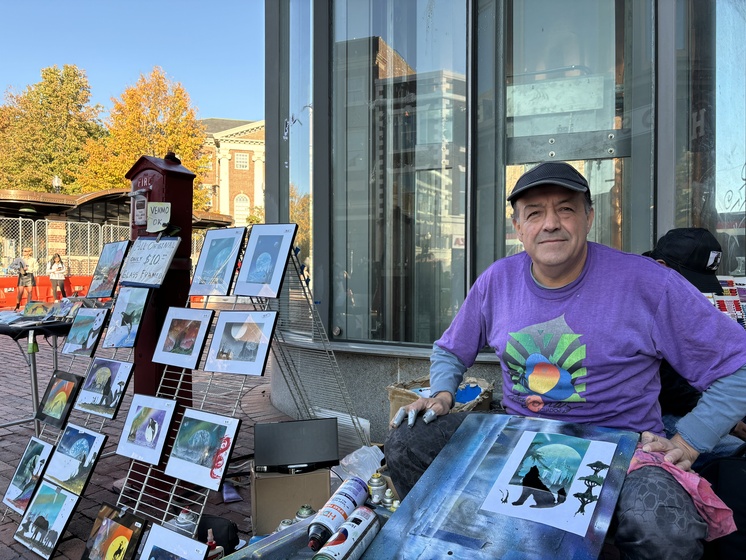{shortcode-47b5b5fac863e560a084587b993b81ad048d1648}
{shortcode-dff00239893dfc2f65d0d2901925e39f12f982db}eople pass through Harvard Square every day, from students rushing to their lectures to tourists streaming in and out of the COOP. The Square’s street performers, though, aren’t going anywhere.
Over the years, the area has become home to a vibrant group of entertainers, from singing guitarists to spray-paint artists. For many of them, the Square is not just a platform for their performance but also a source of many years of memories.
Despite the long history of performance in the Square, street performers are no longer as ubiquitous as they used to be. Some performers claim that the area used to be more lively, drawing larger crowds of engaged viewers. Still, there are several artists keeping the performance scene in the neighborhood alive.
“I have been doing my spray-paint performance here for 23 years,” says Antonio Maycott. On every other Saturday afternoon, he sits nestled against the glass elevator in front of the Harvard T stop. Having painted for so long, he has seen freshmen grow into fathers — “they already have kids and they come to visit me,” he says with a wistful smile.
But, he says Harvard Square isn’t quite the haven for street art that it used to be.
“Years ago, it used to be more alive — more performers, more fun,” Maycott says. Today, Maycott feels that people are busier. “They don’t have the time to stop and talk,” he says. According to him, this is why many performers have left for greener pastures. A rock band used to play in Harvard Square’s “Pit” every Saturday — the sunken patio outside of the T station — but this is no longer the case.
Still, several performers have chosen to stay in the Square. Maycott is one of many artists who make Brattle St. their stage.
Kyla G. Spears and her mother, Liveta F. Kanon, are a mother-daughter duo who have serenaded pedestrians on the streets for years, and they take their art seriously. “You care so much about what you are doing, and you want people to enjoy it,” Spears explains.
The pair originally started their tradition of street performing in Memphis, Tenn., but they have since become regulars at Harvard Square after moving to Cambridge during the pandemic. Spears and Kanon love sharing music from their hometown and feel that Cambridge residents have embraced their style. “Boston is super supportive if you have a talent,” Spears says, and her mother nods in agreement.
Spears and Kanon are not the only performers using music as a way to share their culture. Myriam Ortiz, inspired by her Puerto Rican roots, often performs Caribbean and Latin American folk music that is rich in political messages and holds historical significance. When we approach her, she is midway through a rendition of “Playa Girón,” a song by Cuban musician Silvio Rodríguez about the 1961 Bay of Pigs Invasion.
Ortiz breaks away from her regular role as Chief of Community Engagement at Boston Public Schools to perform with her guitar in Harvard Square every weekend. For her, music is not just a hobby but a form of self-expression.
Ortiz wishes that people paid more attention to the arts. “Art can be incorporated as a tool for just about anything that we do,” she says, citing mental health and language development as examples.
{shortcode-92cc371da15be316528ec38be74f6941db31d1d3}
Maycott similarly sees his art as a form of relaxation, and he enjoys refining his craft and producing new designs over the years. He gestures to a stand full of his framed paintings: dreamy, celestial compositions in which howling wolves and leaping orcas are backlit by a glowing moon. He has retained his distinct style over the years — when The Crimson interviewed him in 2013, he was already creating otherworldly landscapes.
William C. Hoo-Lee, a newcomer to the scene, started performing with his guitar in Harvard Square because he appreciates that street performance “creates culture that is free,” he says.
Though the performance scene has changed in the Square, Hoo-Lee has still managed to find a sense of belonging. He breaks into a smile when telling us stories about his memories with Violin Viv, another Harvard Square regular.
{shortcode-b743f4024e494da7502ee552dabd1c846e5aa702}
This sense of camaraderie encourages artists to return every week. When asked what ultimately makes performing worthwhile, all of the street performers had the same answer: spreading joy.
“I love the feeling of knowing that you’re interesting a kid for the first time in something, or making them enjoy something, just that cute feeling,” Ortiz says.
“It’s good to see a mother giving their daughter a dollar to show appreciation to someone else,” Hoo-Lee says, explaining that both performers and spectators share happiness with one another.
Some performers find it rewarding to have a positive impact on the lives of students. Spears shares that she enjoys talking to students moved by her performances, sending them well wishes on their bright futures.
Through their music, painting, and more, street performers bring Harvard Square to life.
— Magazine writer Kaysia E. Harrington can be reached at kaysia.harrington@thecrimson.com.


